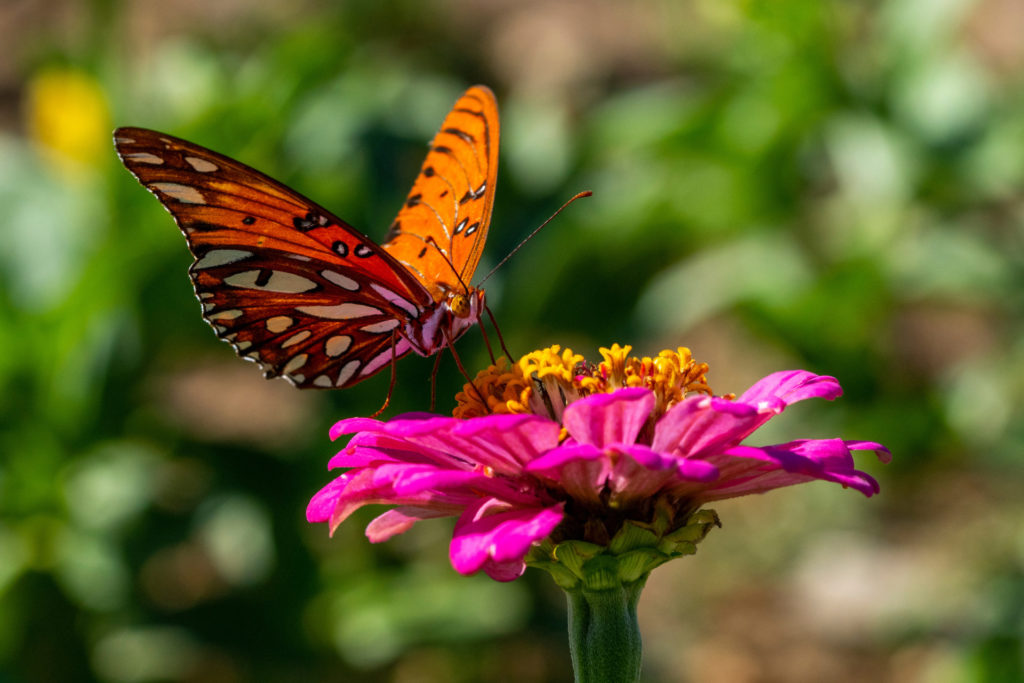- La Feria Community Holds Succesful Business Mixer Event
- Little Nashville to Take Place in Downtown Mercedes
- Lions Basketball Captures District Gold
- La Feria ISD Students Compete in Regional Chess Tournament
- Lions End First Half of 32-4A on a High Note
- La Feria ISD Held Another Successful Parent Conference
- Strong Appearance for Lions at Hidalgo Power Meet
- LFECHS Students Get to Meet Local Actress
- Students Participate in Marine Biology Camp
- Two LFECHS Students Qualify for All-State Band
New Moon Marks End Of Monarch-Spotting Season
- Updated: November 6, 2022
Last chance for Texans to catch a glimpse before butterflies continue to Mexico

Written by Susan Himes
A Texas A&M AgriLife Extension Service expert wants Texans to know that time is running out to spot monarch butterflies on their annual migration to Mexico.
“West Texas welcomed the annual migration of monarch butterflies earlier this month, which means that winter is coming and that the monarchs have returned from their arduous journey to the northern states and are on their way back to the Sierre Madres,” said Gregory Wilson, AgriLife Extension integrated pest management specialist, San Angelo.
Wilson said he expects the migration to conclude before the new moon as monarchs struggle to fly when temperatures dip below 55 degrees.
“I’d encourage Texans to take some time to appreciate this event while you still can as populations have been on the decline since the 1990s,” he said.
There are two main types of monarchs in the U.S. The eastern monarch butterflies spend winters in Mexico and they are the ones we see passing through Texas. Western monarchs, found west of the Rockies, make up just 1% of the contiguous U.S. population and do not have the same migratory patterns as the eastern monarchs.
A multi-generational journey
The monarch’s journey begins in the northern U.S. and southern Canada. No one monarch completes the entire roundtrip. It takes several generations of butterflies to complete the process.
“Long-distance migration is possible because they can detect ultraviolet polarized-light to orient themselves to the horizon and they glide for great distances using warm-air currents, or thermals, to lift them to 1,200 to 10,000 feet in the air,” Wilson said
Most generations of monarchs will live just for two to six weeks as adults, but adults in the autumn migratory generation can live for up to nine months.
The first generation of butterflies born after wintering in the mountains of Central Mexico then travel from the south to recolonize their more northern breeding grounds, and the cycle starts over again.
Four to five generations and a few months later, conditions in North America start to change again as the day length shortens and the food supply becomes exhausted. Temperatures also decline, which signals to the monarchs that it is time to migrate south. Migrating adult’s advance south at an average of 25 miles per day.
How to help the monarch migration
It is too late to do much to help the current migration, but Wilson said now is the perfect time to prepare for the next time monarchs pass through.
While moving north, migratory adults quickly seek out milkweed, which are the only plants from which monarch larvae can derive the correct nutrition for the molting process.
The single most important thing anyone can do is add one or more types of milkweeds to their garden or rangeland. Those who already have milkweed need to stop pulling it and eradicating the plant, Wilson said. In Texas, there are five types of milkweed species you can plant: antelope horn, green antelope horn, zizotes milkweed, swamp milkweed and butterfly weed.
Most weed-management programs remove milkweed from large acreages of landscape exactly when they are most needed by the monarchs in the spring and summer, Wilson said. These areas include urban spaces, rural areas, open range, forest edges, road and byways, canals, railroads and agricultural land. In turn, this reduces the total area that milkweed is distributed annually, significantly reducing total population
“By adding milkweeds and flowers-for-nectar to existing gardens and natural habitats, you help monarchs continue onward in the next leg of their journey,” he said.
He said Texans wanting to do even more can visit Monarchwatch.org for information on the Monarch Waystation Program. The organization attempts to offset the loss of milkweed on the landscape by constructing habitats monarchs can utilize.
“Not only are the primary hosts being eradicated from the landscape but so are their alternate hosts; stands of oyamel firs are being reduced in Mexico due to illegal logging, which reduces the total number of overwintering adults,” Wilson said.
Almost endangered
Wilson said the International Union for Conservation of Nature has already placed monarchs on the Red List of Threatened Species and the butterflies could be classified as an endangered species by the U.S. Fish and Wildlife Service as soon as 2024.
“Studies suggest that total population numbers are on the decline due to the loss of natural habitat,” he said. “Before 1850, the great mid-continental grasslands spanned from southern Wisconsin to western Montana and from Central Texas to Canada.”
That great prairie was once completely covered by grasses and isolated patches of wildflowers and forests, which “functioned like migratory steppingstones.” The once continuous prairie is now a patchwork of exotic and native species that is highly disturbed, with millions of acres of fields prepared for agriculture and uncountable miles of extensive urbanization, Wilson said.
Monarchs congregate in very large groups ranging from thousands to tens of thousands at their winter habitat, which is how their populations are measured by scientists who estimate the population size by measuring the area of trees turned orange by the clustering butterflies.
“Yearly counts show that monarch populations are still in decline as of 2022,” Wilson said. “Only 2.84 hectares, or 7 acres, were occupied by monarchs for their winter habitat at last count.”
By comparison, from 1994-2000, monarchs occupied about 20- 44 acres of land at their overwintering site. From 2001-2007 it was roughly 22-27 acres; from 2007-2010 it dropped to around 10-12 acres; and from 2011-2015 it was between 2-7 acres, he said.





